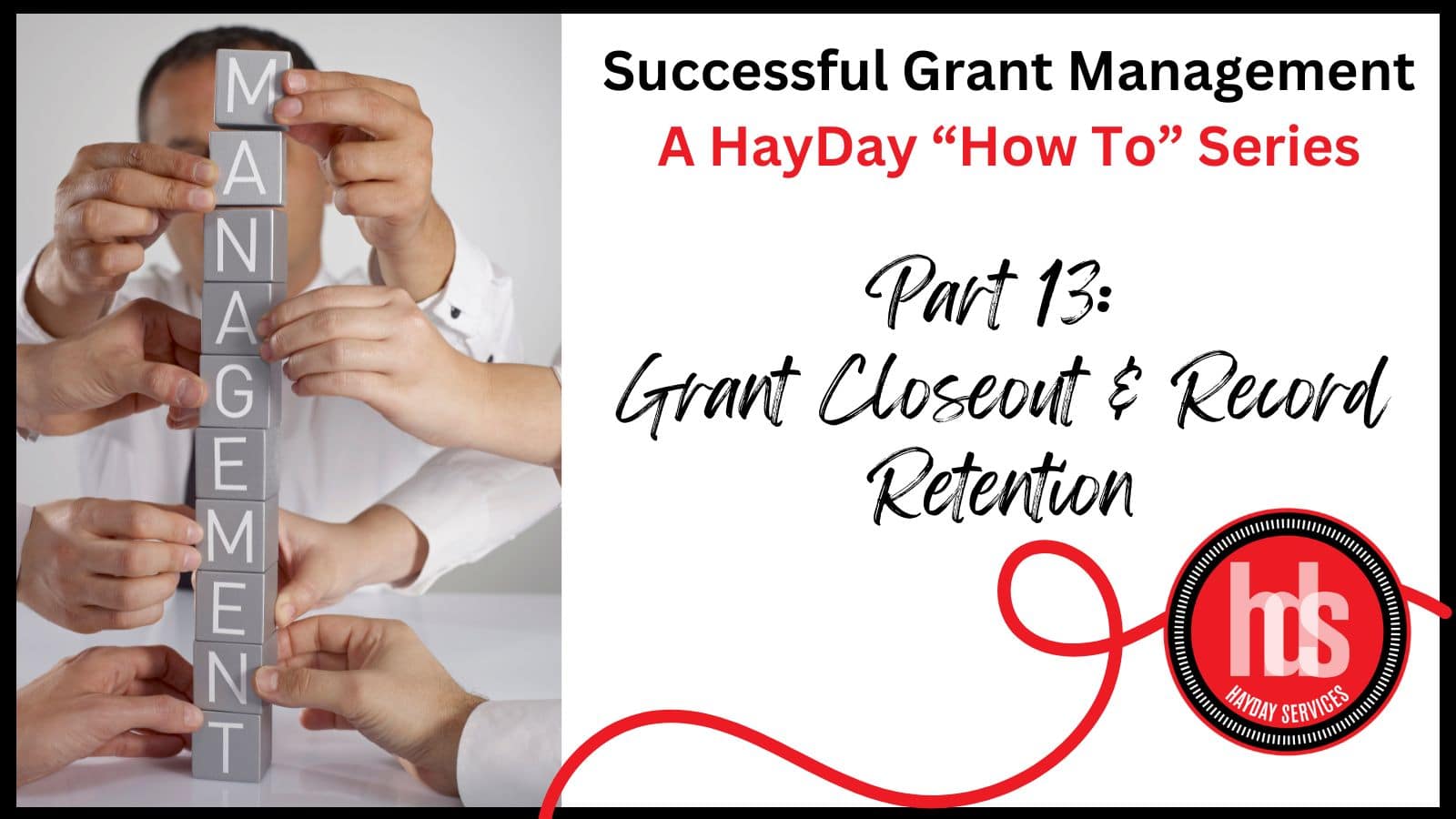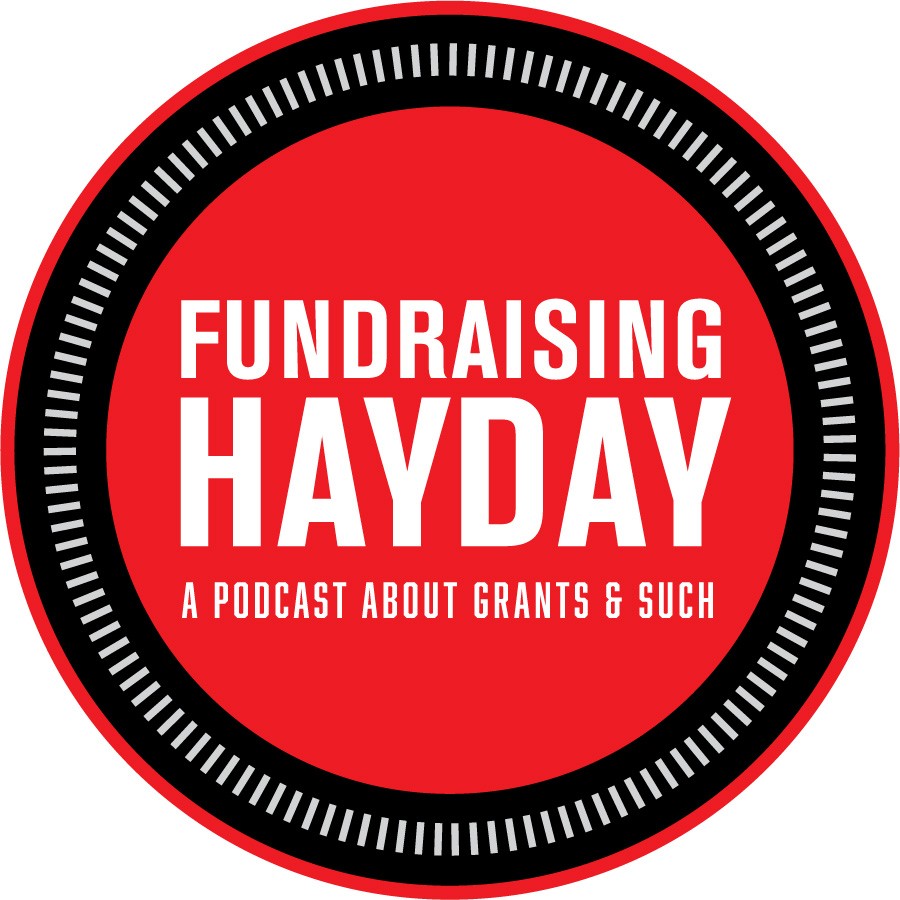HayDay Services is bringing you a series of “how-to” articles related to successful grant management.
Part 13: Grant Closeout & Record Retention
Sure, I love to celebrate when I hit the submit button. And I really break out the happy dance when I get notice of a grant award. Truthfully though, the happiest day for this grant professional is when the grant is officially closed.
I want to shout from the rooftops hallelujah, yay we did it, now pass the cornbread!!! (For my non-southern friends, cornbread is more than a side dish; round these parts it’s a symbol of community and hospitality and goodness – so yes, pass the cornbread!)
Grant closeout is a big deal. It means you implemented your program. You met the grant management requirements. You spent the money. You turned in all the reports. You. Did. All. The. Things. And now that’s one less grant you need to worry about.
Oh wait, did I just say closeout is the end of your work? If only it were that easy. Grant closeout means the end of a lot of work, but not all the work. Yep, grant funding, especially federal grant funding, is the gift that keeps on giving. Let me count thy ways…
CLOSEOUT PROCESS
When you are nearing the end of your grant award period, it’s time to start thinking about the grant closeout process. Directions should be spelled out in your award agreement, but it never hurts to reach out to your funder and ask for final instructions.
Typically, funders will want a final narrative report that includes a summative review of your evaluation. There is also one last financial report. If your funder still owes you any reimbursements, now is the time to point that out. There may be other final reports you have to submit.
Once everything is submitted and reviewed, your funder should send you a closeout letter. This could be a letter or email – the important thing is you get written communication that says “this grant is closed.” Until you have it in writing, the grant is open and your funder can continue to ask for information. You want that letter.
RECORDS RETENTION
The closeout letter starts the clock on your retention period. At a minimum, all grant files must be maintained for three years from the closeout date. Some funders require a retention period of five or seven years – so confirm the official timeline in your award agreement.
Files can be maintained as physical (hard) copies or electronic copies. Once your retention period is over, you can destroy your files. In fact, I recommend you do because: (1) storage capacity is typically at a premium and (2) as long as you have said files you have to provide them to your funder when asked or to anyone who submits an open records request (for those of you who work at government agencies).
And listen, I understand that it is hard to say goodbye to your grant files. As a grants administrator, those files were like my babies. I had labored over them and worked hard to raise them right, but just like there is a time to let your actual children leave the nest, there is a time to say goodbye to old files. Trust me, you’ll have plenty more in the future to care for.
Want to read more about record retention? Check out Section 200.334 of 2 CFR Part 200.
BEYOND CLOSEOUT, MANAGEMENT & DISPOSITION OF EQUIPMENT
One of those pesky requirements that doesn’t end at closeout is the management and disposition of any equipment purchased with federal funds. As of the date of this article, equipment are items that cost $10,000+ per item.
Here’s a few things that Section 200.313 of 2 CFR Part 200 has to say about use of equipment.
- You “must use equipment for the project or program for which it was acquired and for as long as needed, whether or not the project or program continues to be supported by the Federal award.”
- “When no longer needed for the original project or program, the equipment my be used in other activities in the following order of priority:
- Activities under other Federal awards from the Federal agency that funded the original program or project; then
- Activities under Federal awards from other Federal agencies.”
- In addition, “use for non-federally-funded projects is also permissible, provided such use will not interfere with the purpose for which it was originally required.”
For example, many years ago I worked for a city that purchased a SUV and trailer with funds from the Federal Emergency Management Agency. The purpose was to transport HazMat equipment to sites as needed. Thankfully, we didn’t have daily HazMat incidents, so we were also able to use the vehicle and trailer for other needs of the city’s fire and police departments.
During the grant period, and after, your organization is required to keep up with all equipment purchased with federal funds. Specifically, you must:
- Keep property records for equipment that includes a “description of the property, a serial number or another identification number, the source of funding for the property, the title holder, the acquisition date, the cost of the property, the percentage of the Federal agency contribution towards the original purchase, the location, use and condition of the property, and any disposition data including the date of disposal and sale price of the property.”
- Conduct a physical inventory of the property at least once every two years
- Have a system in place to protect against property loss, damage, and theft
- Keep up with regular maintenance
- Follow sales procedures that ensure the highest possible return.
When you’re ready to dispose of the equipment, it’s not as easy as selling or donating it. First you need to determine the current market value of said piece of equipment. If it’s $10,000 or less (per unit), you can pretty much handle it like you would any other piece of equipment. But if the value is greater than $10,000 you must follow the funder’s disposition instructions.
Please note: funder’s are supposed to provide you with those instructions when you request them. If they fail to provide them within 120 days of your request, you’re back to following your own protocols. However, if they provide instructions, you must follow them. Chances are, you will have to pay a portion of the sale’s proceeds to the funder.
Like I said, federal grants are the gifts that keep on giving.
IN CLOSING (see what I did there)
It’s important to close out your grant so your retention clock can start, but it doesn’t mean your work on that grant is completely over. If you purchased any equipment through a grant, you must keep up with that. My suggestion is that you work hand-in-hand with whomever is your organization’s equipment manager. Chances are, someone in finance keeps up with all equipment (part of your organization’s assets).
And remember to track your retention period so you can destroy records when the time comes. Setting reminders on your calendar and/or in your project management software can help you keep track of it all.
Then maybe you can go out and enjoy some cornbread. If you’re ever in Savannah, my mom makes a mean batch.
Amanda Day, GPC, is a national trainer and speaker. With 20 years of grant prospect research, writing, and management experience, she has the knowledge, know-how, and stories to keep every workshop participant and conference attendee engaged and better prepared to succeed in the grant profession. She is well versed in federal and private grant funding, as well as educating up and using your professional network to best build career path. Her passion lies in preparing grant professionals to successfully fund their organizational and community needs, along with meeting their personal career and leadership goals.
Latest posts by Amanda Day
(see all)




